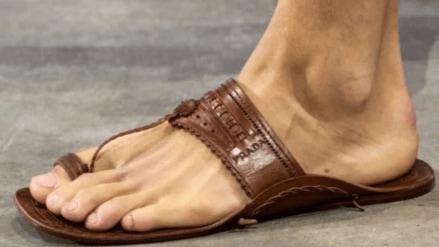Italian fashion giant Prada is facing serious backlash in India after launching a high-end sandal that closely resembles the traditional Kolhapuri chappal, with no credit or acknowledgement of its Indian origin. The loudest voice in the growing chorus of criticism is that of Sambhaji Chhatrapati, a direct descendant of the Maratha royal family and an ex-member of Parliament. Calling Prada’s move “new-age colonialism under the garb of fashion,” Sambhaji accused the brand of cultural appropriation and erasure of centuries-old Indian craft.
“The foreign fashion house @Prada has just launched a sandal under its own label that is virtually indistinguishable from our traditional Kolhapuri chappal—one of India’s most cherished heritage crafts,” he wrote on X (formerly Twitter). “By making no mention of its origin, history, or the centuries-old mastery of Kolhapur’s artisans, Prada has gone beyond mere design inspiration; they’ve repeated a pattern of cultural dispossession.”
Sambhaji emphasised that the Kolhapuri chappal is more than just footwear; it is a living symbol of regional identity, artisanal heritage, and community livelihood. The craft flourished under the royal patronage of Rajarshi Shahu Chhatrapati Maharaj, who supported Kolhapur’s cobblers and leatherworkers in the early 20th century.
In 2019, the chappal was awarded Geographical Indication (GI) status, officially recognising its unique origin and protecting it from unauthorised imitation. Sambhaji argued that Prada’s product ignores this legal and cultural context entirely. He described Prada’s omission as a case of “daylight robbery,” where a powerful global brand profits from traditional Indian design while erasing the artisans behind it. “Copying the design, concealing its true provenance, and marketing it under a global luxury label is nothing short of theft of our shared legacy,” he stated.
Ethical recognition vs. exploitation
Sambhaji noted that had Prada engaged ethically with Indian artisans through fair sourcing, royalties, or even proper attribution, the launch could have served as a powerful celebration of Indian craftsmanship on the global stage. Instead, the brand’s silence and lack of transparency have provoked widespread outrage on social media and within artisan communities.
In his statement, he issued a two-fold call to action for Prada: “First, publicly credit the chappal’s Indian roots—the patronage of Rajarshi Shahu Chhatrapati Maharaj, and the artisan clusters of Kolhapur. Second, establish fair licensing or design collaborations with Kolhapur’s tanneries and cooperatives, ensuring artisans receive due recognition, royalties, and opportunities for co-creation.”
He urged both the Government of India and consumers to take action. According to him, it’s time for India to defend its cultural and economic interests in the global creative economy. “Fashion must be inclusive, not extractive,” he asserted. “The Government of India should act decisively against companies that unlawfully appropriate our millennia-old crafts, and as consumers, we must stand in solidarity with the artisans who have nurtured these traditions for centuries.”
This isn’t the first time
Prada’s Kolhapuri-inspired sandal is only the latest example in a long history of South Asian designs being co-opted by global luxury brands without credit. Earlier in 2025, Japanese label Puebco sold a simple cotton bag, identical to the everyday jholas used across Indian markets, on Nordstrom for $48, marketing it as an “Indian Souvenir Bag.” Similarly, the bindi, long worn by Hindu women as a cultural and spiritual symbol, has been rebranded as a “face jewel” at music festivals and fashion runways in the West, often stripped of its original significance and turned into a decorative trend.
From dupatta-like scarves being sold as “Scandinavian wraps” by brands like Toteme, to kurtas and shararas being passed off as boho chic outfits by luxury houses such as Gucci and Oh Polly, the pattern remains the same: traditional South Asian garments are repackaged, renamed, and resold at eye-watering markups. In one instance, a kurta-like top was listed for $3,500, while a sharara was marketed as a “lace-up gown” until online backlash forced the brand to acknowledge its real roots.
“Let’s ensure that when an authentic Indian product—deeply rooted in culture and community—enters the global marketplace, its genuine identity travels with it,” he said. “Through respect, collaboration, and fair acknowledgement, we can make sure global fashion uplifts rather than erases living heritage.”
